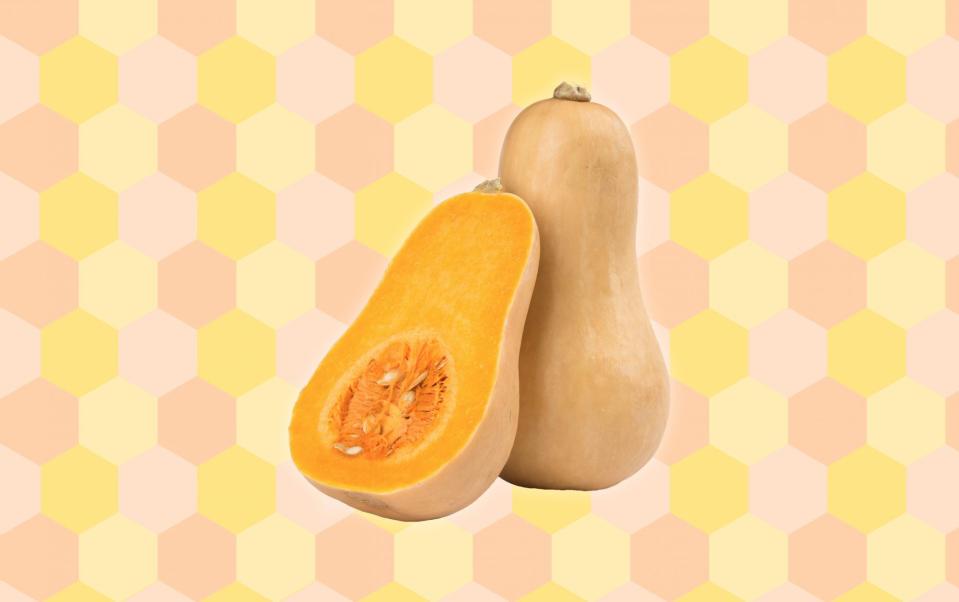How to Make Butternut Squash Puree for Babies
Filled with vitamin A and potassium, butternut squash is nutritious and delicious. Follow our easy step-by-step instructions to make butternut squash puree.

Making baby food purees, such as butternut squash, from scratch is a lot simpler than you might think. And butternut squash puree is an excellent first food for your baby. It has a sweet and nutty flavor, and it takes on a velvety texture when roasted. Butternut squash is also as nutritious as it is delicious. Each serving contains potassium, vitamin C, vitamin A, vitamin B6, magnesium, iron, and dietary fiber.
Like sweet potato puree, it's the ideal flavor complement to a variety of other veggies, fruits, and meats, such as pear, apple, broccoli, strawberry, or chicken. Follow these easy step-by-step instructions to learn how to make butternut squash puree for your baby.
Step 1: Select & Buy Butternut Squash
The peak growing season for butternut squash is early fall through winter. To select the best butternut squash, look for one that is firm and free of cracks, bruises, or soft spots. If you are purchasing a package of peeled, cut butternut squash, choose squash with a deep orange color. In fact, the deeper the color, the riper and sweeter it is. A roasted 1.6-pound butternut squash yields about 14 ounces of puree.
Related:What to Know About Feeding Your Baby the First Year
Step 2: Wash and Prep the Butternut Squash
Start by rinsing the butternut squash in cold water. Then, scrub the skin with a small vegetable brush to remove dirt. If you've purchased pre-peeled and cut butternut squash, place the pieces in a colander and rinse with cold water.
Related:Introducing Solids With Allergy Awareness
Step 3: Cook the Butternut Squash
The ideal cooking method for a butternut squash puree depends on whether you are using a whole or cut squash.
Whole squash
Cut the butternut squash in half lengthwise (leave the skin on). Use a spoon to scoop out the seeds. Place squash on a baking sheet that has been brushed with a bit of olive oil and roast at 400 degrees F. Check the squash after 30 minutes to see if it is soft and can be easily scooped with a spoon. If not, keep adding 5 minutes of roasting time until it has softened. Remove the squash from the oven and scoop the flesh into a bowl. Allow it to cool.
Peeled and cut squash
Bring water to a boil in a medium saucepan. Add the squash pieces and cook until tender, about 15 minutes. Drain and rinse squash under cool water to stop the cooking process.
Alternatively, use the above roasting technique. Begin checking the cut pieces for softness after about 20 minutes as smaller pieces will cook faster.
Related:12 Healthy Finger Foods That Don't Come From a Box
Step 4: Puree the Butternut Squash
Puree the cooked butternut squash in a food processor or blender until smooth. Add water, formula, or breast milk as needed to reach the desired consistency.
When your baby is first eating solid foods, aim for a smoother, lighter texture. As they get more adept at eating, the consistency can get a bit thicker. Once your baby is ready for finger foods, typically around 10 months, you can serve them chunks of butternut squash that have been cooked until tender and cut into tiny pieces.
Related:
Step 5: Serve Butternut Squash Puree
Butternut squash is very mild in flavor. It's an ideal food to introduce as a first vegetable to your baby. Once they have gotten used to eating single foods, you can continue to serve them butternut squash by itself or mixed with other veggies, fruits, meats, and spices. Try mixing butternut squash puree with:
A dash of cinnamon or nutmeg
Applesauce
Beef
Chicken
Lentils
Peaches (with or without yogurt)
Pear
Pork
Rice
Spinach
Turkey
Yogurt
Related:
Step 6: Refrigerate or Freeze Leftover Butternut Squash Puree
Cool butternut squash puree and refrigerate leftovers in BPA-free containers for up to 3 days. Freeze leftovers for up to 3 months. Thaw overnight in your refrigerator.
Related:

